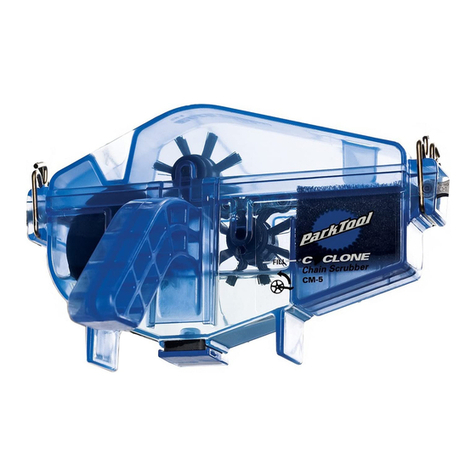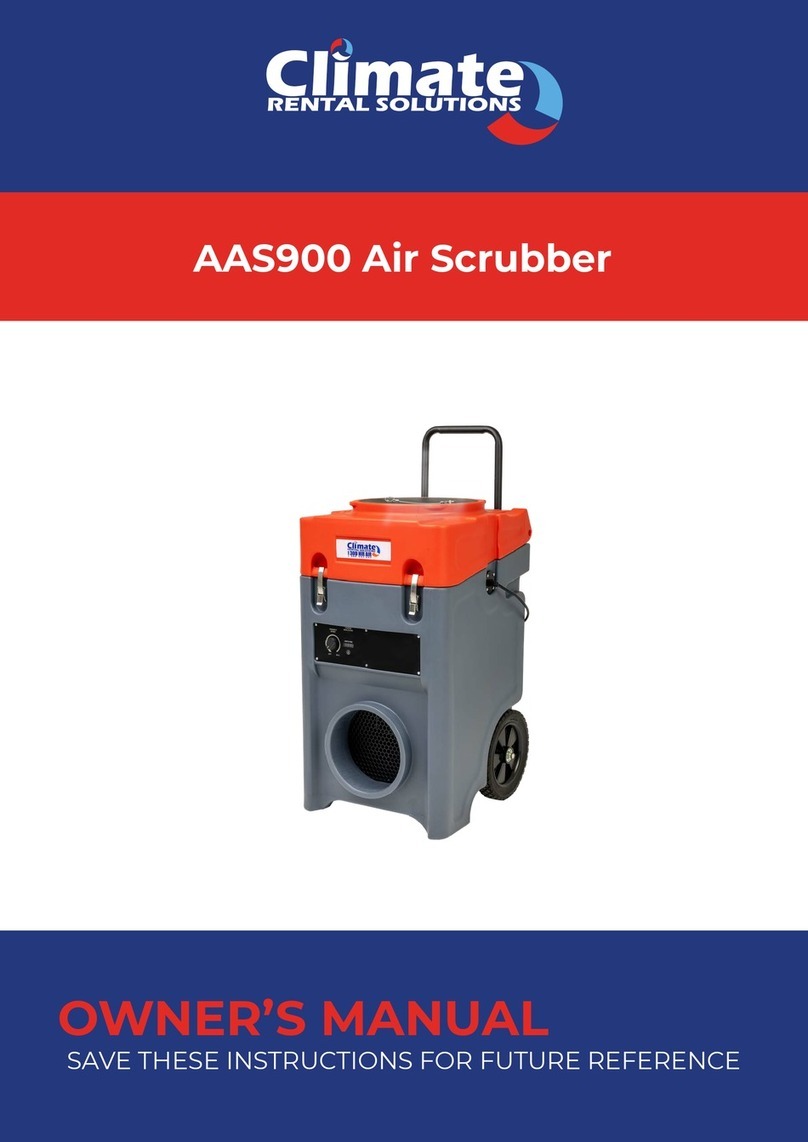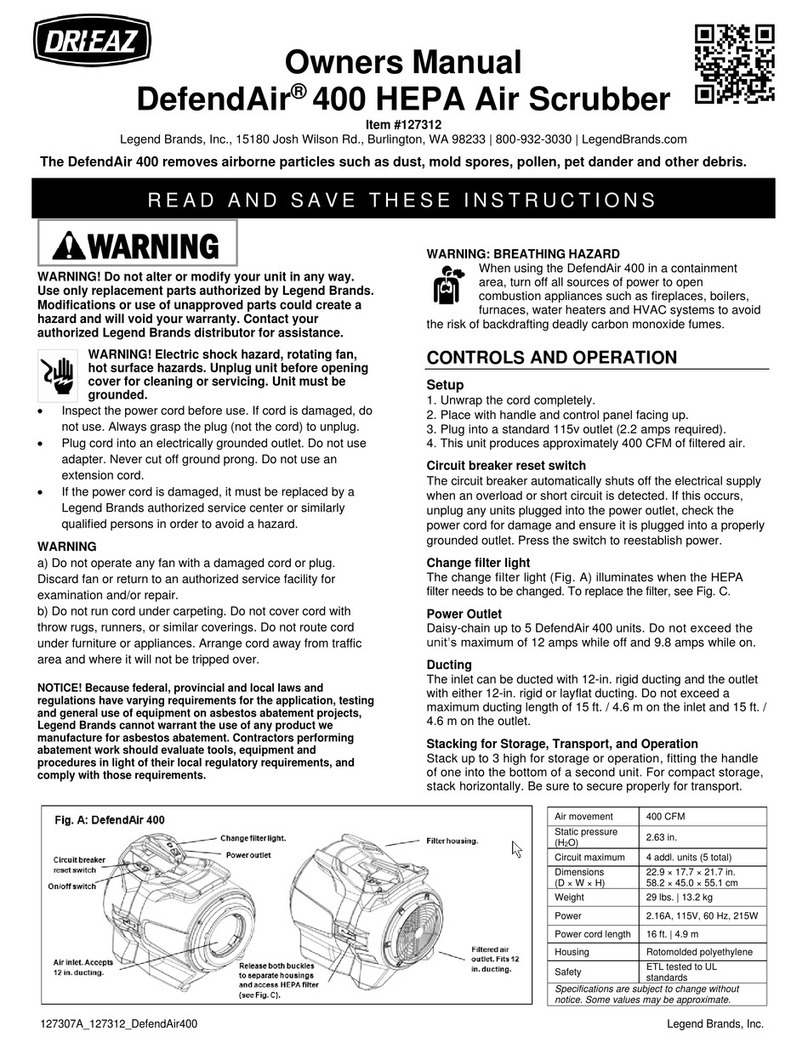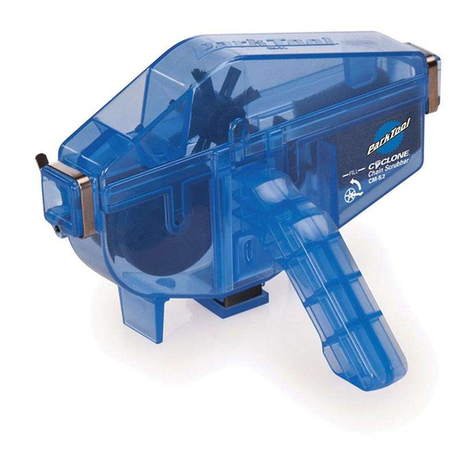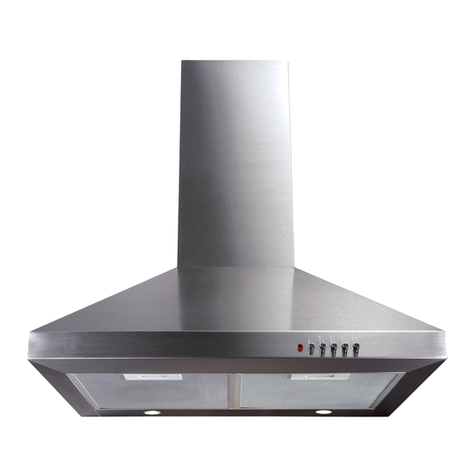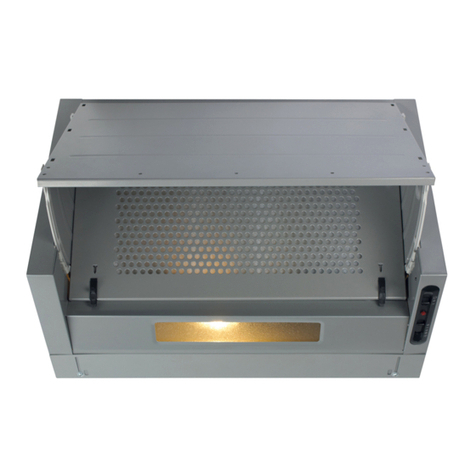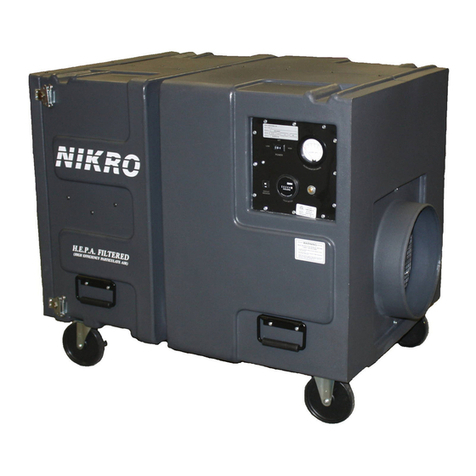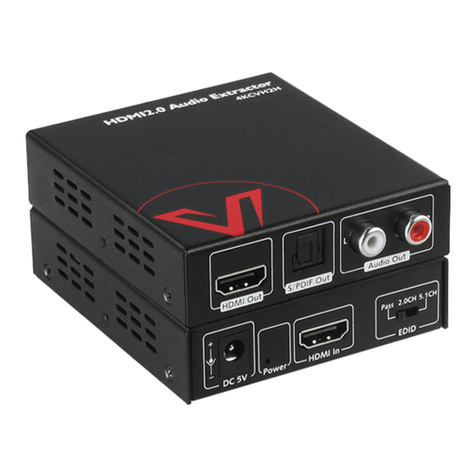Westin STRATUS Air Installation and operating instructions

STRATUS Air
Ceiling Built-in Unit
Installation, Operation and Maintenance
CONTENTS
INTRODUCTION
IMPORTANT INFORMATION
EXTRACTION PERFORMANCE
INSTALLATION
SPECIFICATIONS
OPERATING INSTRUCTIONS
MAINTENANCE
GENERAL ARRANGEMENT
DRAWINGS & ILLUSTRATIONS
1
2
3
4
5
6
7
8
Unpacking
Remove all items from the packaging. Retain the packaging.
If items are missing or damaged, please contact Westin for assistance.
The following items are included:
Remote Control
Console
W S Westin Ltd
Phoenix Mills, Leeds Road, Huddersfield, HD1 6NG, UK
Tel: 01484 421585 Fax: 01484 432420 Email:
www.westin.co.uk
Documentation:
This Manual,
Warranty Card,
Product Fiche and
Energy Label
Stratus Air Main Unit

Ceiling Built-in Unit
STRATUS AIR
Installation, Operating & Maintenance Instructions
W1524 WSW STRATUS AIR Ceiling Extract O&M Oct 16.docx Page 2 Westin
1. INTRODUCTION
During the cooking process, there will be heat, vapours and
fumes produced. Your Westin Ceiling Extractor has been
designed to complement your kitchen both in looks and
performance in order to create a good environment for creative
cooking.
2. IMPORTANT INFORMATION
The exhaust air must not be discharged into a flue which is
used for exhausting fumes from appliances supplied with
energy other than electricity e.g. oil- or gas-fired central
heating boilers, gas-fired water heaters, etc.
Requirements of the relevant authorities concerning the
discharge of exhaust air must be complied with.
Pay particular attention to fire risk when frying. To minimise
the risk of fire, all instructions relating to cleaning the grease
filters and removing grease deposits must be adhered to.
Do not flambé under the extractor.
The clearance between the hob burners and the bottom
surface of the extractor must be at least 750mm to prevent
overheating of the extractor and its components.
Please also note that a 90o bend in flexible ducting will require
215mm minimum headroom to give a smooth radius with no
kinking.
You are advised to install measures designed to reduce the
incidence of cold draughts entering the property via any
ductwork.
For extractors with internal or inline motors, this
should, at the very least, consist of an external duct
termination with integrated non-return flaps (e.g.
gravity shutter wall grille/louvre) and/or an inline
backdraught shutter.
For wall-mounted motors, an inline backdraught
shutter is recommended.
3. EXTRACTION PERFORMANCE
As its name suggests, this type of extractor is designed to fit
into the ceiling void, with only the underside and outer flange
visible when installed.
Because fumes spread out as they rise, a unit larger than the
hob area is desirable, although not always possible. The
perimeter extraction system is designed to conceal the grease
filters and to minimise fume escape. Warm cooking fumes that
do escape tend, initially, to accumulate in the highest part of
the room, so situating the unit at the highest point is of benefit.
It will perform best when it is situated directly over the hob.
The primary influence on the overall performance of the
extractor is the design of the ducting which takes the exhaust
air from the extractor to the outside. The duct route should be
a prime consideration during the initial stages of the kitchen
design (Westin do not recommend recirculating air back into
the kitchen).
Please note the following:
Easy access to the duct route during installation is
important. Lack of access may require the “blind” fitting of
flexible ducting, with increased risk of unseen kinks and
impaired efficiency.
The extractor is provided with a spigot suitable for
connecting 150mm diameter ducting.
Note: the cross-sectional area of 150mm diameter duct is
the minimum area consistent with efficient extraction.
The most efficient configuration is to duct straight through
an outside wall, so try to position the cooker against an
outside wall when designing your kitchen.
Your extractor can be set to vent to the rear, front, left or
right. Use the exhaust position which gives the shortest
achievable duct route and least number of bends. Joist
positions will often determine what is achievable.
Rigid 150mm round ducting or an equivalent flat channel
system (available from Westin) will perform best, with
semi-rigid (often referred to as flue liner) being the second-
best solution. Flexible ducting is economical but it’s use
should be minimised as it gives the worst performance and
should only be used for short duct runs or initial connection
(and should be pulled taut to prevent significant losses in
extraction efficiency).
For maximum efficiency, ducting should be kept as short
as possible and as straight as possible with a constant
cross-sectional area being no less than that recommended
by Westin. Bends in the duct will also degrade
performance so the number of bends in a duct run should
be kept to a minimum and be gradual and smooth to
prevent turbulence. Avoid kinks in flexible ducting; pull
flexible ducting taut over straight runs to ensure that the
internal surface is as smooth as possible.
WARNING.
Proper care must be taken to ensure that the negative
pressures caused by high performance extraction
systems do not adversely affect the safe operation of
certain types of fuel-burning appliances (gas, oil or solid
fuel), including those installed in the kitchen and
possibly also those installed in other parts of the house.
Where such fuel-burning appliances are installed,
adequate ventilation MUST be provided in the room of
installation, located and sized such that the negative
pressure in the room created by the extractor does not
exceed 4Pa.
In case of doubt, do not operate the extractor and fuel-
burning appliance(s) simultaneously and consult an
appropriate (for the fuel type) expert for advice.
ELECTRICAL SAFETY.
This appliance requires an earth connection.
Ensure that the supply voltage corresponds to that
marked on the rating label inside the extractor.
The extractor must be isolated from the electrical
supply before carrying out any cleaning or
maintenance operations.
This extractor has no lights, however there is a light
control button on the remote-control console.
So this button may be of use, a switched 230V AC
electrical output is provided, operated by the light
button. You will find a terminal box, containing Live,
Neutral & Earth wires that can be used to power your
own auxiliary lights (up to 100W), or ignored according
to preference.

Ceiling Built-in Unit
STRATUS AIR
Installation, Operating & Maintenance Instructions
W1524 WSW STRATUS AIR Ceiling Extract O&M Oct 16.docx Page 3 Westin
4. INSTALLATION
The extractor is designed for installation within a cut-out in the
underside of the kitchen ceiling. Alternatively, it may be
installed within a lowered area of ceiling or a soffit panel within
your furniture – remember though that it is desirable to install
directly into the ceiling (see section 3).
Please note the following.
The extractor is made up of two main parts*:
o The “top box”, which houses the exhaust ducting
spigot, grease filter, electrical connection points and
any internal motor.
o The “baseplate”, which is essentially the visible parts
when installed, comprising hinged filter concealment
door panel assembly and outer frame.
The ducting spigot must be set to the required outlet
position prior to installation (Left, Right, Front, Rear or
Top).
The Stratus Air “top box” has 3 possible duct spigot
positions. It is easily separated from the baseplate and can
be rotated through 180 degrees in order to achieve all 5
possible outlet directions. It is secured via screws
accessible only when the filter concealment door panel is
in the open position.
The extractor fixing holes are located behind the door
panel. We recommend pan-head or flanged screws are
used to secure the extractor, rather than countersunk.
Screw heads will be visible only when the door is open.
If your extractor is a recirculating model (optional extra
and not the standard configuration) then adequate
provision must be made for exhausted air to return to the
kitchen, such as by ducting to a vent in the kitchen ceiling
(located so as to minimise uncomfortable draughts onto
occupants). Failure to do so may cause the unit to
overheat and fail, and will invalidate your warranty.
This extractor has no lights, however there is a light control
button on the remote-control console.
So this button may be of use, a switched 230V AC
electrical output, operated by the light button is provided.
You will find a terminal box, containing Live, Neutral &
Earth wires, that can be used to power your own auxiliary
lights (up to 100W) or ignored according to preference.
4.1. Opening the filter concealment door panel.
The panel is held shut with magnetic catches.
Open the panel by grasping it close to the corners on the
catch side (the long edge opposite the hinges) and pulling to
release the panel from the magnets. Take care not to let the
panel fall open freely, it should be supported and moved
carefully into the open position.
4.2. Setting the Duct Spigot Position.
Your extractor ducting spigot can be set to vent to the Left
(factory default), Right, Front, Rear or Top.
The front of the unit, when installed, is the side with the
magnetic catches.
Note: If you wish to vent upwards and space is restricted, then
you may find your installation easier if you use a side outlet
position and put a bend in your ducting.
The “top box” exhaust spigot assembly refers to the removable
150mm ducting spigot plate, which in the case of Internal
blower models has the motor attached to it.
As described earlier, the Stratus Air “top box” has 3
possible duct spigot positions, with the remainder being
achieved by rotating the top box through 180 degrees.
To change the exhaust spigot position of the "top box"
proceed as follows:
Suspend the extractor on its back such that the “top box” is
clear of the ground. Tip. This can be achieved by placing
the product across the top of the open box it came in so
that the "top box" hangs down into the box.
Open the filter concealment panel and remove the filter(s).
Each exhaust position has 4 captive nuts into which can
be bolted either the exhaust spigot assembly or a blanking
plate.
Bolt the exhaust spigot assembly into the required location
by swapping it with a blanking plate as necessary.
Note: For internal blower models, where space within the
top box is limited, only the screws nearest to the filter
opening need to be fully removed. The screws farthest
away need only to be backed off as the plate has slots for
easier removal/replacement of the motor.
To rotate the "top box" proceed as follows:
Suspend the extractor on its back such that the “top box” is
clear of the ground. Tip. This can be achieved by placing
the product across the top of the open box it came in so
that the "top box" hangs down into the box.
Open the filter concealment door panel to reveal the fixing
screws securing the “top box” to the “baseplate” and
remove the screws.
Carefully lift the "top box" out of the "baseplate" opening,
rotate it to face the required direction and carefully refit it in
its new position, taking care not to trap any wires. Secure it
with the screws previously removed.
4.3. Revealing the Fixing Holes.
The extractor is secured through 4 fixing holes located close
to each corner of the baseplate (see diagrams on Page 7
Onwards for detail).
The fixing holes are only accessible with the door panel open.
4.4. Prepare Opening
Prepare an opening in the ceiling into which the unit will be
fitted (see table below). Refer to the drawings on Page 7 & 8
for detailed opening design and clearance height information.
Unit Size (mm)
(Width x Depth)
Cut-out Size (mm)
(Width x Depth)
880 x 420 860 x 400
1180 x 420 1160 x 400
Reinforce the opening as necessary and make suitable
provisions for the screws that will hold the unit in place.
Tip: Because much of the baseplate only intrudes into the
ceiling by 30mm (see diagrams on Page 7 Onwards),
providing the joist direction runs such that the top box can be
Dimensioned drawings and illustrations to help with
your installation can be found on page 7 onwards.
Important.
The "top box" needs to be angled during removal and
refitting to allow the duct spigot, electrical connection
points and cables to clear the opening in the "baseplate"
.

Ceiling Built-in Unit
STRATUS AIR
Installation, Operating & Maintenance Instructions
W1524 WSW STRATUS AIR Ceiling Extract O&M Oct 16.docx Page 4 Westin
accommodated, alterations to joists and any boxing down can
be kept to a minimum, or avoided altogether if the ceiling
thickness is sufficient or ceiling can be lowered slightly.
4.5. Ducting
Install ducting taking note of the advice given in section 2 & 3.
We recommend using semi-rigid round ducting for this
extractor – the initial connection to the extractor spigot must
be in semi-rigid (or flexible duct) to allow the unit (or top box if
fitting separately) to be installed with the duct connected.
Run the ducting such that there is enough to easily reach just
beyond the centre point of the extractor, thus allowing for a
short length to be pulled through the opening for later
connection to the top box spigot. Try to avoid tight bends
immediately adjacent to where the top box will be, as this will
make pushing the unit/top box into position more difficult.
When terminating ducting on an outside wall, a suitable
weather louvre should be used. Ducting components and
complete kits are available from Westin for most installations.
If you need to use expanding foam, make sure that any soft
flexible ducting is supported internally to prevent it crushing, or
use semi-rigid/rigid ducting where foam is used.
For roof or chimney duct terminations, please contact Westin
or seek alternative specialist advice.
If you are fitting a wall-mounted external motor with semi-rigid
or flexible ducting, then you must leave a short length (approx.
200mm) of expanded (stretched out) ducting proud of the wall
to facilitate connection to the motor spigot before pushing both
into position flush with the wall.
Standard external motors come with a cable assembly that
must pass through the wall and run back to the extractor –
usually this passes alongside the ducting so it is
recommended to oversize your cut-out by at least 25mm to
allow for this and easy installation of the duct.
4.6. Remote External Wall and Inline Motors
If your extractor has been purchased to operate with a
standard inline or external remote motor (SEM), then you will
find a black plastic box outside the extractor (on flying leads)
containing electrical terminals for connection to the remote
motor cable assembly. This box is referred to as the remote
motor terminal box.
Run the remote motor cable such that sufficient hangs down
through the ceiling opening prepared for the extractor to allow
for easy connection to the remote motor terminal box.
Each terminal inside the remote motor terminal box has one
side connected to a coloured wire (leading back to the hood
control system). The remote motor cable also has coloured
wires and these are connected to the empty terminals such
that corresponding colours are opposite and connect to each
other; i.e. red connects to red, blue to blue, and so on…
Not all terminals will be used as each remote motor type is
configured differently.
No separate power supply is required for the external motor.
An electrician (or Part P registered electrical installer) should
undertake any work associated with the electrical installation
of SEM remote motors.
Please refer to the REMOTE MOTOR ILLUSTRATIONS on
page 9 for more information.
If you need to extend the remote motor cable, then additional
cable can be purchased from Westin. Alternatively, it can be
extended using 7 core x 0.5mm flex. It is vital to ensure that
any new cable is inserted such that the core colour integrity is
maintained; i.e. a core that started as red must terminate as
red, blue as blue, purple as purple, and so on.
Any remote motor should be installed in accordance with the
installation instructions that accompany it. It must be installed
in an easily accessible location for future maintenance. Westin
are not responsible for providing the means of access (e.g.
scaffolding or any alterations to the building and/or furniture
necessary to make access possible) in the event of any
maintenance requirement.
4.7. Electrical Installation
The extractor is a fixed electrical appliance and must have a
provision for isolating the electrical supply via a switched-
fused spur located in an accessible position within the kitchen.
A qualified electrical technician must perform the installation of
the electrical supply to the extractor.
The hood must be fed from a dedicated 230Vac single
phase electrical supply terminated with a switched spur
fitted with a 3A fuse. The switch should be located so that the
supply can be disconnected from the extractor using the
switch at any time following installation (the switch must be
accessible). The means of disconnection from the supply must
have a minimum contact separation of 3mm in all poles.
Alternatively, a means of disconnection in the fixed wiring
according to the relevant wiring rules must be fitted.
A supply cord for connecting the extractor to the spur is
included. The mains supply is connected to the free end of this
cord as follows:
INCOMING SUPPLY CORD CONNECTIONS
Core Core Colour
Live Brown
Neutral Blue
Protective Earth Green/Yellow
For your convenience during installation we recommend
terminating the electrical supply from the switched- fused spur
with a standard UK 3 pin 240V socket positioned close to the
extractors intended location. The extractor's electrical supply
cord can then be fitted with a standard 240V 3 pin plug for
easy connection to the supply during installation.
Make sure the switched - fused spur supplying the extractor is
in the ‘off’ position before connecting the appliance to the
electrical supply.
Because this extractor has no lights but the remote controller
retains a light control button, we provide a switched 230V AC
electrical output that can be used to power your own auxiliary
lights (up to 100W) or ignored according to preference. You
will find a small terminal box containing Live, Neutral & Earth
wires to power lights, should you wish to use it.
4.8. Fixing the Extractor in Position
Please note the following prior to commencing fixing the
extractor in position:
You will need at least 2 people to fit this extractor; to lift,
hold and fix the unit in position:
A working platform or scaffold should be used so that the
ceiling opening can be reached and the unit fixed without
the use of ladders.
ELECTRICAL HAZARD.
DISCONNECT ELECTRICAL SUPPLY
BEFORE PROCEEDING FURTHER

Ceiling Built-in Unit
STRATUS AIR
Installation, Operating & Maintenance Instructions
W1524 WSW STRATUS AIR Ceiling Extract O&M Oct 16.docx Page 5 Westin
Screws for fixing the extractor into position are not
provided. You must use suitable fixings capable of
supporting 30kg.
If you are screwing into timber, then you should use
screws no smaller than 5mm (No 10) with a head diameter
of 10mm or more and ensure that at least 35mm of thread
is screwed into the timber and that the timber will not split
when the screws are inserted.
The unit will need supporting close to the opening when
attaching the ducting and making electrical connections –
do not be tempted to install excessive ducting as this will
impair performance.
As described earlier, a length of semi-rigid ducting
protruding a short distance through the centre of the
ceiling opening is sufficient for the final connection to the
extractor spigot. This will allow the unit to be fixed into
position with the duct connected and prevents excessive
lengths of flexible ducting being pushed into the opening
(and the resultant losses in efficiency which that would
cause (see section 3)).
Note that it is possible to separate and withdraw the spigot
assembly back into the top box (working through the filter
opening). Whilst this should not be necessary, it is worth
noting as it may help you overcome difficulties, particularly
if your ducting has been cut too short, as you will be able
to attach it to the spigot from inside the extractor.
If you have not already done so, set the top box to duct out in
the required direction, as described in section 4.2, and reveal
the corner fixing holes, as described in section 4.3.
If you wish to power lights of your own with this extractor,
then these should be wired into the switched 230V AC
output terminals provided now. Note: Should you wish to,
auxiliary mains powered lighting of up to 100W can be
powered by this extractor. Terminals can be found within the
small lighting terminal box (see diagrams on Page 7
Onwards). A qualified electrical technician must be used to
connect any auxiliary lighting to this appliance.
If using a remote motor, connect it now, as described in
4.6. The illustrations on page 9 will help you.
Support the extractor just below the prepared cut-out so that
the spigot and electrical connections are accessible.
Make sure that the electrical supply to the electrical
supply spur is isolated (switched off) and connect the
electrical supply cord of the extractor to the spur.
Attach the ducting to the spigot using suitable clamps or
straps. We do not recommend using duct tape as the only
means of fixing ductwork.
Now push the extractor (and any wires and terminal
boxes) up into the cut-out, taking care not to crush or
introduce excessive bends/kinks in the ducting and making
sure that no wires are trapped or damaged in the process.
Note: If the duct or any wires are trapped, then you must lower
the extractor and make corrections to the cut-out area as
necessary, before fixing the appliance in position.
Secure the extractor in place using suitable fixings (not
supplied) through the fixing hole in each corner of the
baseplate.
Now test the function of the unit as described in the operating
instructions (Section 6).
If the unit does not function correctly then isolate the electrical
supply and check all the electrical connections before
contacting Westin.
If you experience any difficulties, please call Westin for advice.
4.9. Removing the Motor Transport Ties (If Fitted) (see fig.2)
Note: Transport Ties are only used on smaller appliances to
protect the motor during unpalletised transit.
5. SPECIFICATIONS
All Models
Supply voltage:
230V~ 50Hz
Recommended fuse size for electrical supply:
3A
Extractor Duct spigot
diameter:
150mm
Stratus Air with Internal Motor
Motor airflow in free air:
800 m3/hr
Blower power input:
275W
Total power:
276W
Stratus Air with SEM1 EL Inline Motor
Motor airflow in free air:
800 m3/hr
Motor power input:
275W
Total power:
276W
Stratus Air with SEM2 EL External Wall Motor
Motor airflow in free air:
900 m
3
/hr
Motor power input:
200W
Total power:
201W
Stratus Air with SEM7 EL External Wall Motor
SEM7 airflow, in free air: 200mm Dia Duct
1,700 m
3
/hr
SEM7 airflow, in free air: 150mm Dia Duct
1,500 m
3
/hr
Motor power input:
490W
Total power:
491W
Note: The motor has a 200mm diameter spigot and is supplied with a
reducer for connection to 150mm ducting.
Stratus Air with SEM8 EL Inline Motor
SEM8 airflow, in free air: 200mm Dia Duct
1,300 m
3
/hr
SEM8 airflow, in free air: 150mm Dia Duct
1,100 m
3
/hr
Motor power input:
250W
Total power:
251W
Note: The motor has a 200mm diameter spigot and is supplied with a
reducer for connection to
150mm ducting.
Important Note: Any optional auxiliary lighting powered by this appliance is
not included in the stated power figures shown above.
Maximum wattage of auxiliary lights (not supplied or)
you may power with this appliance:
100W
You must consider and allow for the future removal
of the extractor and any remote motor when
planning and undertaking your installation in case
future access for servicing is required.
ELECTRICAL HAZARD.
DISCONNECT ELECTRICAL SUPPLY
BEFORE PROCEEDING
FURTHER
Fig. 2

Ceiling Built-in Unit
STRATUS AIR
Installation, Operating & Maintenance Instructions
W1524 WSW STRATUS AIR Ceiling Extract O&M Oct 16.docx Page 6 Westin
6. OPERATING INSTRUCTIONS
Switch on the power at the fused spur.
The unit is operated by radio remote control.
Should the extractor fail to respond to commands from the
remote-control console, then please check that the power
is on and the internal appliance reset switch is in the ‘On’
position (factory default). The reset switch is a latching red
push-switch located in the chamber behind the grease
filter(s).
Press the switch fully in to change between ‘on’ and ‘off’
modes. If you are unsure as to the position of the switch,
you can repeatedly press the light switch on the remote
control console during the boot sequence (which lasts
about 15 seconds) to register the remote to the appliance.
- When registered, if the switch is in the ‘on’ position, you
should hear the lighting relay inside the hood click quietly,
or if you have lights connected, they will illuminate.
Should your remote-control stop working, you should
install a new battery before seeking further assistance.
If you experience interference problems or the remote
appears to be faulty from new, then a different radio
transmission code may be required.
Refer to the instruction leaflet included with the radio
remote control console regarding battery replacement and
transmission code changes before seeking assistance.
* The automatic speed reduction feature is required to
comply with EU Ecodesign and Energy Labelling
legislation. Our highest performance SEM remote motors
require speeds to automatically reduce to speed 2.
5. MAINTENANCE
Regular maintenance is essential to ensure good performance
and long-life.
To maintain the immaculate appearance of the extractor, and
to minimise fire risk, ensure that grease deposits on the
extractor surfaces are kept to a minimum by regular cleaning.
To clean the stainless-steel surfaces of the extractor, use a
soft cloth and a suitable cleaning agent, such as a specially
produced stainless-steel cleaner or washing up detergent and
warm water.
Painted surfaces should be cleaned using a soft cloth,
detergent and warm water.
Glass surfaces should be cleaned with a suitable glass
cleaning agent.
Do not use abrasive cleaning materials or products.
Do not use bleach-based cleaning materials or
products.
Clean the grease filters in a dishwasher or by hand-washing in
hot water and detergent every 2 months - sooner if the
extractor is used extensively and filters become grease laden.
Whilst you can expect years of service from mesh grease
filters, they are considered a consumable item and may
deteriorate over time and need replacement, particularly
when cleaned in a dishwasher. For dishwasher users
adhering to a 2 monthly cleaning interval we recommend
grease filter replacement every 5 years to maintain
optimum performance, even if they show no visible signs
of deterioration. For all users, filters should be replaced
whenever they exhibit signs of physical wear.
Accessing the filter(s) and baseplate
The panel is held shut with magnetic catches.
Open the panel by grasping it close to the corners on the catch
side (usually the long edge opposite the hinges) and pulling to
release the panel from the magnets. Take care not to let the
panel fall open freely, it should be supported and lowered
carefully into the open position.
No lights are supplied with this extractor.
CAUTION.
To minimise the risk of fire, all instructions relating
to cleaning the grease filters and removing grease
deposits must be adhered to.
W S Westin Ltd
Phoenix Mills, Leeds Road, Huddersfield, HD1 6NG, UK
Tel: 01484 421585 Fax: 01484 432420 Email:
www.westin.co.uk
Remote Control Functions
The extractor controller will automatically switch
off the appliance if there has been no operator
action for 4 hours.
Motor ON /OFF DECREASE SPEED
RUN ON TIMER
(MOTOR OFF after 10
minutes to clear fumes)
INCREASE SPEED
Speeds 2,3 and Timed
Intensive Speed 4
(Intensive speed reverts
automatically to a lower
speed after 5 minutes *)
Lights
ON/OFF
(only if auxiliary are
lights connected)
Function Pressed
Indicator LEDs

Ceiling Built-in Unit
STRATUS AIR
Installation, Operating & Maintenance Instructions
W1524 WSW STRATUS AIR Ceiling Extract O&M Oct 16.docx Page 7 Westin
This extractor has no lights, however there is a light control button on the remote control console.
We therefore provide a switched 230Vac electrical output (switched on/off when the light button is
pressed) and a terminal box (containing Live, Neutral & Earth wires) that can be used to power your own
auxiliary lights (up to 100W) or ignored according to preference.
This extractor has no lights, however there is a light control button on the remote control console.
We therefore provide a switched 230Vac electrical output (switched on/off when the light button is
pressed) and a terminal box (containing Live, Neutral & Earth wires) that can be used to power your own
auxiliary lights (up to 100W) or ignored according to preference.

Ceiling Built-in Unit
STRATUS AIR
Installation, Operating & Maintenance Instructions
W1524 WSW STRATUS AIR Ceiling Extract O&M Oct 16.docx Page 8 Westin
Typical cut-out detail:
Joists running in line.
Magnetic
Catch
Top Box
Fixing
Screws
Fixing Holes
(screws not
supplied)
Stratus Air with Door Open
Showing Fixing Arrangement
Unit placed within
typical cut-out detail
Set support surface 35mm
up from opening so the
extractor can be pulled up
flat against the ceiling by
your fixing screws.
Do not overtighten screws.
The extractor hangs within
the aperture created.

Ceiling Built-in Unit
STRATUS AIR
Installation, Operating & Maintenance Instructions
W1524 WSW STRATUS AIR Ceiling Extract O&M Oct 16.docx Page 9 Westin
SEM-EL REMOTE MOTOR WIRING ILLUSTRATIONS for Energy Labelling Directive Compliant Motors SEM1, 2, 7 and 8
Red
Blue
White
Grey
Black
Green/Yellow
Brown
Orange
Yellow
Purple
Fig. 4 SEM 1 / SEM 2
Electrical Connections
Fig. 5 SEM 7/ SEM 8
Electrical Connections
Fig. 3 Terminal Colour Positions
Remote Motor
Cable Assembly
(Orange/Yellow link
wire
is
included
)
Remote Motor
Cable Assembly
(Orange/Purple link
wire
is
included
)
Remote Motor
Terminal Box
Fig. 1 Open Terminal Box
Empty Terminal for
Motor Connections
Extractor
Fig. 2 Typical System (SEM2 Shown)
SEM 7
Only
Other manuals for STRATUS Air
1
Table of contents
Popular Scrubber manuals by other brands

Bulldog Scrubbers
Bulldog Scrubbers SS20 user manual
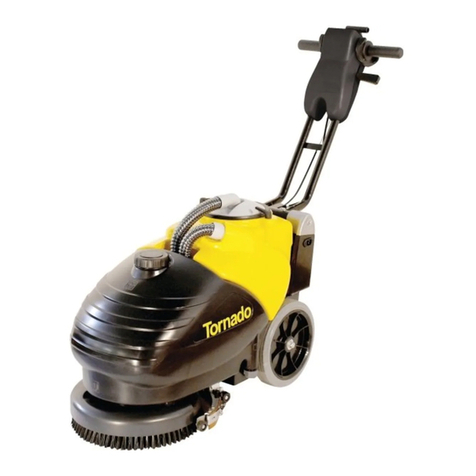
Tornado
Tornado BD 14/4 Operation & maintenance manual
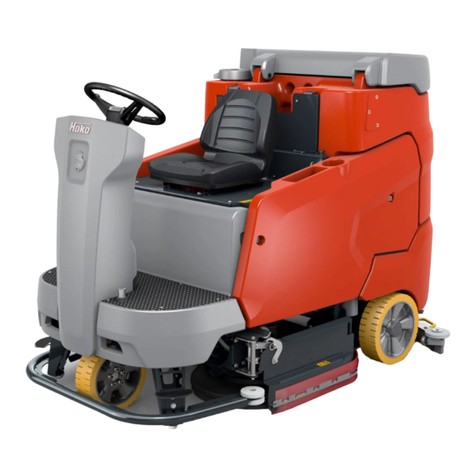
HAKO
HAKO Scrubmaster B260 R operating manual

Matrix
Matrix MEH Manual for installation, use and maintenance
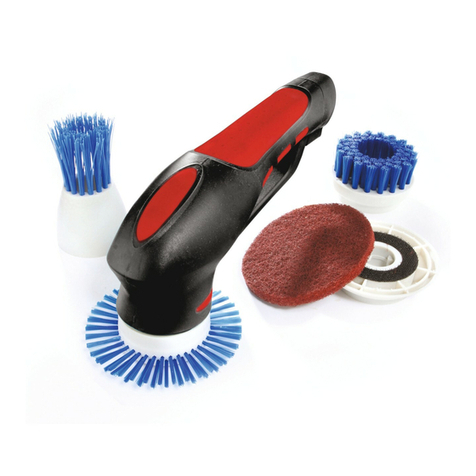
Bergman Pro
Bergman Pro 3190738 instruction manual
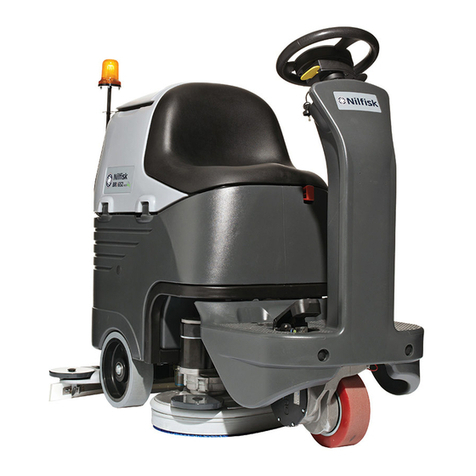
Nilfisk-Advance
Nilfisk-Advance BR 652 Instructions for use
